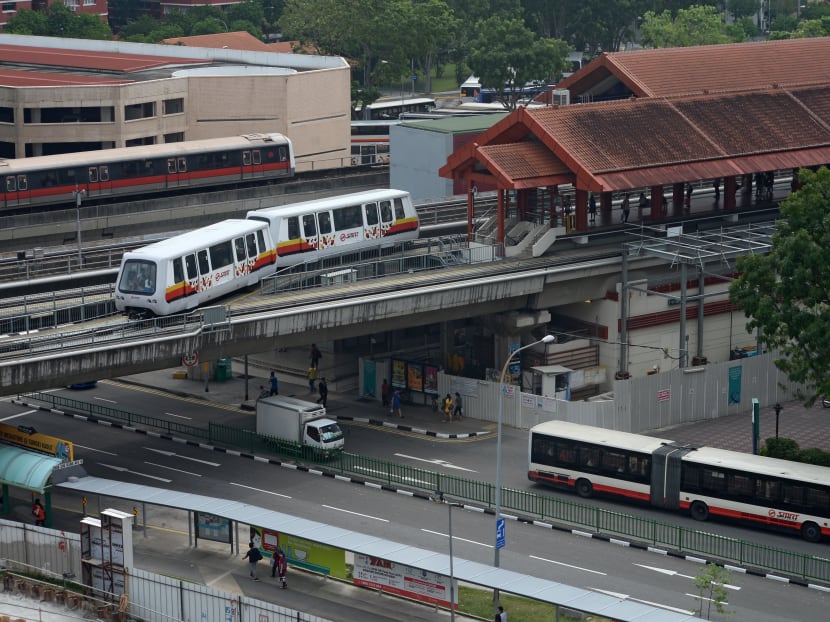Review to overhaul Bukit Panjang LRT under way
SINGAPORE — As the beleaguered Bukit Panjang Light Rail Transit (BPLRT) system nears the end of its 20-year lifespan in 2019, several options are being considered to “completely transform” it, operator SMRT has revealed, including scrapping the network and returning to the use of buses — though the regulator has come out to say this idea is “not likely to be practical”.
SINGAPORE — As the beleaguered Bukit Panjang Light Rail Transit (BPLRT) system nears the end of its 20-year lifespan in 2019, several options are being considered to “completely transform” it, operator SMRT has revealed, including scrapping the network and returning to the use of buses — though the regulator has come out to say this idea is “not likely to be practical”.
In a blog post published on its website on Monday (Oct 3), SMRT Train’s managing director Lee Ling Wee said the company and the Land Transport Authority (LTA) are jointly reviewing the future of the 10.5km, 14-station BPLRT, which has been dogged by problems — including a breakdown just last week, and ongoing issues with the trains’ air-conditioning system.
Acknowledging that the system, which was Singapore’s first LRT network in 1999, continues to “test the mettle of our engineering staff and the patience of users”, Mr Lee wrote that SMRT and the LTA are looking for a solution that will be “more than just a makeover” and will “completely transform the light rail system”.
“The disruption last week has driven home the urgency of planning for the future,” said Mr Lee, referring to the eight-hour disruption on Sept 28 to services to and from Choa Chu Kang that was caused by a track fault.
In his post, Mr Lee laid out a few options being considered in the review.
One, switch to autonomous guided vehicles that would continue to use existing viaducts, but will not draw on external power.
Two, replace it with a new LRT system that has “significant” design enhancements to key infrastructure, such as power supply, signalling system, rolling stock, as well as track and station assets.
Three, renew the existing Bombardier system with a more advanced signalling system that will allow more trains, faster speeds and closer headways, so that it can accommodate more commuters and cut travelling time.
Another idea Mr Lee floated, which he described as “not far-fetched”, was to do away with the S$285 million network and put in enhanced bus services to serve the growing town.
He noted that the capacity of a double-decker bus was 130 passengers, more than the 105 for a single Bombardier CX100 train car, but he conceded that it may lead to more congestion on the roads.
In response to queries, the LTA said going back to an all-bus option “is not likely to be practical given road capacity”.
“We are carefully evaluating the various options given the implications on residents and commuters,” a spokesperson added.
Residents and Members of Parliament (MPs) of the town that TODAY interviewed were also mostly against the idea of scrapping the LRT service, despite the network’s longstanding issues.
Mr Edwin Cheng, 34, who lives near Fajar station, said it would be “a disaster” for traffic conditions.
“Mornings here are crazy for people who live deeper inside Bukit Panjang and the LRT helps them avoid road traffic. Connectivity to the MRT would be gone too. The road situation would be a mess,” he said.
Petir Road resident Chin Moy Kian, 49, felt that LRT breakdowns have become more frequent but still preferred the option over taking buses.
“Residents have already experienced the convenience of taking the LRT to town centres like Choa Chu Kang, which is significantly more comfortable than waiting and riding a bus — although there are at least five buses at the bus stop close to my flat,” said the wholesale retailer. “I don’t see why they need to take it away now that we are all used to it.”
MPs said that whichever option is taken eventually, SMRT needs to improve service reliability in the interim.
Mr Liang Eng Hwa (Holland-Bukit Timah GRC) said residents have long complained of safety and reliability issues.
“It has not served the residents well. There has been feedback on trains not stopping at certain stations, jerkiness during the rides, and even air-conditioning problems,” he said.
“The long-term solution may take years to develop and meanwhile, SMRT should still get their act together to avoid disruptions; and should there be breakdowns, to respond expeditiously to minimise inconvenience to commuters.”
Dr Teo Ho Pin (Bukit Panjang SMC) said he was open to the idea of returning to using buses to serve the town, as long as these are elderly-friendly, and there are trunk and feeder services to take residents to nearby transport nodes.
In the blog post, Mr Lee said short-term measures are being taken, including replacing its rail brackets, adjusting motor controller settings for better power reliability, and load-testing trains to reduce power faults.
SMRT’s engineers have also identified “stop-gap” measures to address recurring reliability woes arising from track faults, traction power faults and signalling issues.
He added: “The range of near-term measures should be complemented by an in-depth review of the BPLRT to future-proof the transport system. This will enable the future system to serve Bukit Panjang residents years from now by providing transport options for safe, reliable, comfortable journeys that are cost-effective to operate and maintain.” ADDITIONAL REPORTING BY WONG PEI TING







